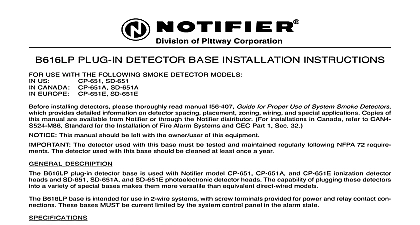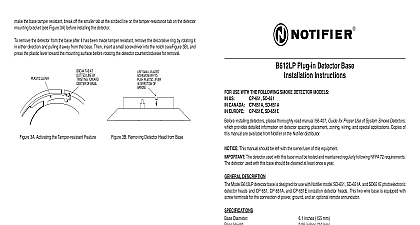Notifier B614LP Installation Instructions

File Preview
Click below to download for free
Click below to download for free
File Data
| Name | notifier-b614lp-installation-instructions-5640718923.pdf |
|---|---|
| Type | |
| Size | 961.63 KB |
| Downloads |
Text Preview
B614LP PLUG IN DETECTOR BASE INSTRUCTIONS USE WITH THE FOLLOWING SMOKE DETECTOR MODELS US CANADA CP 651A SD 651A EUROPE CP 651E SD 651E SD 651 installing detectors please thoroughly read manual I56 407 01 Guide for Proper Use of System Smoke which provides detailed information on detector spacing placement zoning wiring and special appli Copies of this manual are available at no charge from Notifier For installation in Canada refer to CAN Standard for the Installation of Fire Alarm Systems and CEC Part 1 Sec 32 This manual should be left with the owner user of this equipment The detector used with this base must be tested and maintained regularly following NFPA 72 re The detector used with this base should be cleaned at least once a year DESCRIPTION model B614LP detector base is designed for use with Notifier model SD 651 SD 651A and SD 651E photo detector heads and CP 651 CP 651A and CP 651E ionization detector heads This four wire base is with screw terminals for the connection of power ground relay connections and an optional remote It also includes a resistor that limits current when the associated smoke detector is in the alarm state TERMINALS Function 1 2 3 4 5 6 7 8 9 Annunciator used used Annunciator used Relay A Contacts Relay A Relay C Contacts Diameter Height Temperature Range Humidity Range 1 Terminal Layout inches 157 mm inches 24 mm lb 274 g square box with or without plaster ring Min depth inches octagon box Min depth inches to 49 32 to 120 to 93 Relative Humidity Noncondensing Notifier 12 Clintonville Rd Northfield CT 06472 1652 203 484 7161 RATINGS includes base and detector Voltage 120 VAC 60 Hz Contact Ratings or Inductive 60 power factor load A C 30VAC DC 30VAC DC 110VDC 125VAC Seconds Maximum Time 60 second reset detector base mounts directly to 3 1 2 inch and 4 octagon boxes and 4 inch square boxes with or plaster rings To mount the base remove the ring by rotating it in either direction to unhook snaps before separating the ring from the base Use screws supplied with the junction box to attach the to the box through the appropriate slots in the base Figure 2 Position the decorative ring around the and rotate it in either direction until the ring snaps place ON cid 13 NOT cid 13 NOT cid 13 2 Mounting Base to Box GUIDELINES loop resistance is an important specification for control panels as well as for smoke detectors and their The alarm system cannot be expected to operate correctly if system components have incompatible allow loop resistances Therefore before beginning installation refer to the control panel manufacturer loop resis specification to ensure that it is listed as compatible with the base and smoke detector being installed wiring must be installed in compliance with the National Electrical Code and all applicable local codes and any requirements of the authority having jurisdiction using the proper wire size The conductors used to con smoke detectors to control panels and accessory devices should be color coded to reduce the likelihood of errors Improper connections can prevent a system from responding properly in the event of a fire signal wiring the wiring between interconnected detectors it is recommended that the wire be no smaller AWG 18 However the screws and clamping plate in the base can accommodate wire sizes up to AWG The use of twisted pair wiring for the power and loop is recommended to minimize the effects of elec interference 2 I56 647 01 3 Wiring Diagram for a Typical 120VAC Detector System INSTRUCTIONS Refer the manufacturer instructions for releasing device wiring To ensure that electrical connections are supervised DO NOT loop wires under terminals 8 9 10 and 11 cut the wire at each terminal make electrical connections strip approximately 3 8 1 cm insulation from the end of each wire Slide a wire the clamp plate on each side of the terminal screw and tighten the screw the base is being installed in a zoned system check the zone wiring before installing the smoke detector head built in shorting spring makes it convenient to do this After the detector base is wired and attached to the elec box position the shorting spring against terminal 3 Use the slot in the retaining clip to hold the spring against terminal as shown in Figure 1 This shorts the negative in and negative out leads so that loop wiring can be for continuity NOT remove the shorting spring from the base when continuity tests are completed all detector bases have been mounted wired and the wiring checked install the detector heads The short spring in the base automatically disengages when the detector head is removed from the base DO NOT re the shorting spring since it reengages as the detector head is turned into the base completing the circuit FEATURE DO NOT use the tamper resistance feature if the XR2 Removal Tool will be used to remove detectors from base detector base can be made tamper resistant so the detector cannot be detached without the use of a tool To the base tamper resistant break off the smaller tab at the scribed line on the tamper resistant tab on the mounting bracket see Figure 4A before installing the detector 3 I56 647 01 remove the detector from the base after it has been made tamper resistant remove the decorative ring by rotat it in either direction and pulling it away from the base Then insert a small screwdriver Figure 4B into the notch press the plastic lever toward the mounting surface Rotate the detector counterclockwise and remove it LEVER TAB AT LINE BY TOWARD OF BASE SMALL BLADED TO PLASTIC LEVER DIRECTION OF 4A Activating Tamper resistance Feature 4B Removing the Detector Head from the Base LIMITATIONS OF SMOKE DETECTORS smoke detector used with this base is designed to activate and initiate emergency action but will do so only used in conjunction with an authorized fire alarm system This detector must be installed in accordance with standard 72 detectors will not work without power AC or DC powered smoke detectors will not work if the power is cut off for any reason detectors will not sense fires which start where smoke does not reach the detectors Smoldering typically do not generate a lot of heat which is needed to drive smoke up to the ceiling where the smoke detec is usually located For this reason there may be large delays in detecting a smoldering fire with either an ioniza detector or a photoelectronic type detector Either one of them may alarm only after flaming has initiated will generate the heat needed to drive the smoke to the ceiling from fires in chimneys in walls on roofs or on the other side of a closed door may not reach the smoke and alarm it A detector cannot quickly detect or sense at all a fire developing on another level of a build For this reason detectors shall be located on every level and in every bedroom within a building detectors have sensing limitations too Ionization detectors and photoelectronic detectors are required pass fire tests of the flaming and smoldering types This is to ensure that both can detect a wide range of fires detectors offer a broad range of fire sensing capability but they are somewhat better at detecting fast fires than slow smoldering fires Photoelectronic detectors sense smoldering fires better than flaming fires have little if any visible smoke Because fires develop in different ways and are often unpredictable in their neither type of detector is always best and a given detector may not always provide early warning of a spe type of fire general detectors cannot be expected to provide warnings for fires resulting from inadequate fire protection prac violent explosions escaping gases that ignite improper storage of flammable liquids like cleaning solvents ignite other similar safety hazards arson smoking in bed children playing with matches or lighters etc detectors used in high air velocity conditions may have a delay in alarm due to dilution of smoke densities b


